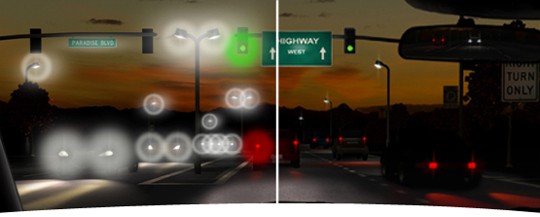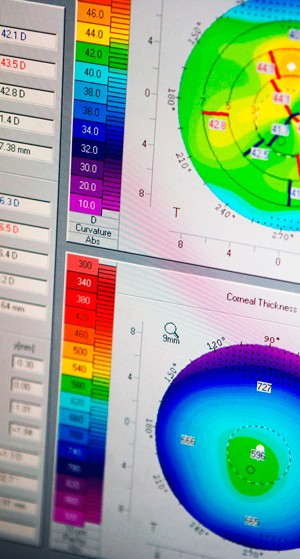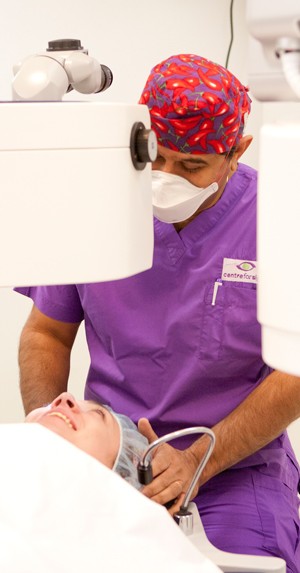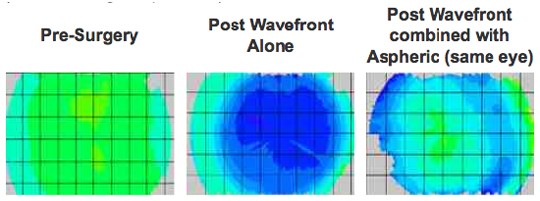
Glare, Halos and Laser Eye Surgery
Laser eye surgery is amazing and liberating. The importance of being evaluated and treated by an expert surgeon cannot be understated. Several issues can be missed and the only way to ensure the surgery being provided is safe is to seek out those who are an expert in the area and fellowship trained in Laser and Refractive Surgery.
“the preoperative evaluation is not to be underestimated…”
Patients are referred to us for a second opinion after Laser Eye Surgery for halos and glare, and in spite of having excellent vision in bright light, cannot see well at night and have difficulty driving. The image above is a simulation of what these patients might see compared to what they should see. Note many experience halos without having had laser eye surgery! The good news is this can be corrected.
Why do halos occur?
“Find a surgeon you can trust…”
First to reassure you – in this modern era of much better understanding as well as phenomenal techology, very few should develop halos or glare. Those with pre-existing night vision problems should obtain an improvement or remain the same following laser eye surgery.
The most common causes of Halos are;
1) Large pupil size in dim light
Pupils are often quite large in the young. This MUST be measured before surgery and the laser treatment zone adjusted in size to suit. For large pupils the minimum size of the laser zone should be 6.5mm and preferably Aspheric (see below)
2) Small zones of treatment
This relates to large pupils. If a small zone of treatment is used in the cornea, and the pupil expands beyond the zone, patients can experience halos and glare.
3) Decentered treatments
Incorrect use of the laser or treatments that are not customised properly for the patient such as ensuring treatment is in the line of sight. The result is similar to having a contact lens on the eye that is off-centred – end result is vision is not good and in dim light conditions there is considerable glare, halo and possibly starburst.
4) High order aberrations – specifically Spherical aberration
Excuse the jargon – this is Wavefront terminology. Shortsight, farsight and astigmatism are “Low” order aberrations. There are a number of “High order” aberrations which adversely affect visual quality. These can increase in laser eye surgery that is not performed well. High order aberrations become significant with large pupils and thus a problem at night. Spherical aberration is well known for causing halos at night and commonly occurs with lasers that do not provide Aspheric profiles.

Avoiding Halos and Glare
1) Find a surgeon you can trust
Find an eye surgeon that is fellowship trained in cornea and laser refractive surgery. They understand the impact of changing corneal shape and will use technology well to avoid troubles or not perform surgery at all.
2) Ensure your pupil size is checked at the time of evaluation
3) Ensure the treating centre uses lasers that provide Aspheric treatments in shortsighted patients
Aspheric treatments attempt to keep the cornea “Prolate” very much like a normal cornea. Although the cornea is flattened in shortsight surgery, an aspheric treatment ensures the cornea remains steeper in the centre and flat on the sides (see image below). Warm colors are where the cornea is steep. In the past lasers flattened corneas in the centre causing spherical aberration. The images below are a simulation on virtual “Treatment Planning” software comparing a non-aspheric treatment with an Aspheric. Notice the cornea before surgery (left image) which has a warm (steep) color in the centre and cooler(flat) color at the sides. The Aspheric simulation (Right image) shows similar warmer colors in the centre with flatteing at the sides. This is MORE aspheric than the cornea preoperatively and promises excellent vision.


When choosing to have Laser Eye Surgery, we suggest you research the surgeon, the technology and where the surgery is going to take place. The importance of being treated and evaluated by an expert surgeon with expert facilities cannot be underestimated! Your eyes are precious and you must keep them that way!
In our last issue we dealt with Dry eye after Laser Eye Surgery. If you missed this issue and would like to learn more click here.
Author Information
Authored by Sheraz Daya MD FACP FACS FRCS(Ed) FRCOphth, Consultant Ophthalmic Surgeon & Medical Director, June 2019.
